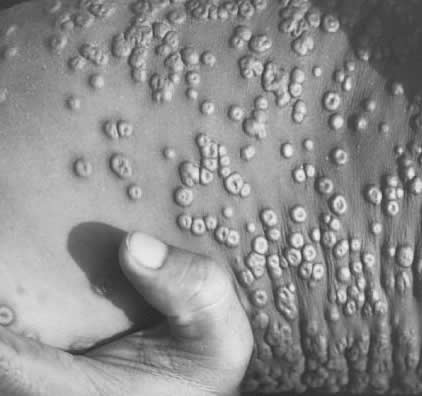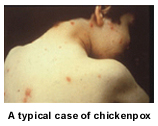
The last known person in the world to have smallpox of any kind. Here 23-year-old Ali Maow Maalin of Merka, Somalia exhibits the pox of Variola minor.
Smallpox
Background and potential as a bioweapon
The deliberate reintroduction
of smallpox into the human population would be a horrible tragedy. Throughout
human history, smallpox has been responsible for the death of millions of people
and the disfigurement of many more. Smallpox is a significant threat to civilian
populations due to its mortality rate of 30% or more among unvaccinated persons
and the fact that there is no specific treatment other than supportive care.
Although smallpox has long been regarded as the most devastating of all infectious
diseases known to man, its potential for devastation is far greater now than
at any time in history. Smallpox vaccination stopped in the U.S. more than 25
years ago. In a now highly susceptible, mobile population, smallpox would be
a true international emergency, as it would be able to spread quickly and widely
throughout the world.
British soldiers in North
America first used smallpox as a bioweapon during the French and Indian Wars.
Soldiers gave blankets to American Indians that had been used by smallpox patients
with the intent of infecting them with smallpox. As a result, smallpox epidemics
wiped out more than 50% of the affected tribes. With the demonstration in 1796
by Edward Jenner that an infection caused by cowpox provided protection against
smallpox, and the rapid worldwide adoption of vaccination, the potential for
a worldwide epidemic of smallpox was greatly reduced.
INSTANT FEEDBACK:
The
use of smallpox against groups of Indians in North America caused a devastating
loss of life.
|
The last known person in the world to have smallpox of any kind. Here 23-year-old Ali Maow Maalin of Merka, Somalia exhibits the pox of Variola minor. |
INSTANT
FEEDBACK:
Due
to the fact that most of the world’s population is not immune to smallpox, the
rate of smallpox transmission could be higher than during any previous epidemics.
 The
virus that causes smallpox occurs in two predominant strains – variola major(right),
which has a 30% or greater mortality rate, and variola minor, with a 1% mortality
rate. Hemorrhagic smallpox and malignant smallpox are two rare but deadly strains
of the disease. Before the introduction of smallpox vaccination, almost everyone
eventually developed smallpox, and either died of it or developed lifelong immunity.
Smallpox is highly contagious. The virus spreads from person to person primarily
by droplet nuclei or aerosols expelled from the throat of infected persons and
by direct contact. Contaminated
clothing or bed linens can also spread the virus. Historically, the seasonal occurrence
of smallpox is similar to that of chickenpox and measles – with incidence
higher in winter and spring. The infectious dose is unknown, but is believed to
be only a few virons. In the 1960’s and 1970’s in Europe, during a very
limited smallpox outbreak, individuals with the infection transmitted smallpox
to as many as 10 to 20 other people.
The
virus that causes smallpox occurs in two predominant strains – variola major(right),
which has a 30% or greater mortality rate, and variola minor, with a 1% mortality
rate. Hemorrhagic smallpox and malignant smallpox are two rare but deadly strains
of the disease. Before the introduction of smallpox vaccination, almost everyone
eventually developed smallpox, and either died of it or developed lifelong immunity.
Smallpox is highly contagious. The virus spreads from person to person primarily
by droplet nuclei or aerosols expelled from the throat of infected persons and
by direct contact. Contaminated
clothing or bed linens can also spread the virus. Historically, the seasonal occurrence
of smallpox is similar to that of chickenpox and measles – with incidence
higher in winter and spring. The infectious dose is unknown, but is believed to
be only a few virons. In the 1960’s and 1970’s in Europe, during a very
limited smallpox outbreak, individuals with the infection transmitted smallpox
to as many as 10 to 20 other people.INSTANT FEEDBACK:
Before
the introduction of smallpox vaccination, nearly everyone developed smallpox
and died from it or developed lifelong immunity.
|
Typical papular pattern |
The incubation period of
smallpox ranges from 7 to 17 days, with an average length of time between exposure
and symptom development of 12 to 14 days. The patient then typically develops
a high fever, malaise, and prostration, with headache and backache. Severe abdominal
pain and delirium are sometimes present. A maculopapular rash then appears on
the mucosa of the mouth and throat, and the face and forearms, and spreads to
the trunk and legs. A person with smallpox is sometimes contagious with onset
of fever (prodrome phase), but the person becomes most contagious with the onset
of rash. The lesions that first appear in the mouth and throat release large
amounts of virus into the saliva. Smallpox pustules are characteristically round,
hard, and deeply embedded in the dermis. Crusts begin to form on about the eighth
or ninth day of the rash. As the patient recovers, the scabs separate and pitted
scars develop, primarily on the face.
 The
majority of smallpox cases present with a characteristic rash that is most dense
on the face and extremities. The lesions appear over a 1 to 2 day period and
evolve at the same rate. On any given part of the body, they are generally in
the same stage of development.
The
majority of smallpox cases present with a characteristic rash that is most dense
on the face and extremities. The lesions appear over a 1 to 2 day period and
evolve at the same rate. On any given part of the body, they are generally in
the same stage of development.  In
varicella (chickenpox) the disease most frequently confused with smallpox, new
lesions appear in crops every few days and lesions at very different stages
of maturation are found next to each other. Varicella lesions are much more
superficial and are almost never found on the palms or soles. Chickenpox also
has a much greater concentration of lesions on the trunk than on the face and
extremities.
In
varicella (chickenpox) the disease most frequently confused with smallpox, new
lesions appear in crops every few days and lesions at very different stages
of maturation are found next to each other. Varicella lesions are much more
superficial and are almost never found on the palms or soles. Chickenpox also
has a much greater concentration of lesions on the trunk than on the face and
extremities.
Management
Unfortunately, there are
no drugs currently available to treat smallpox. At this time, treatment consists
of supportive therapy plus antibiotics as needed for treatment of secondary
bacterial infections. Although some antiviral agents are being studied for their
effect on the smallpox virus, no antiviral substances have yet proved effective
for the treatment of smallpox.
Except for the lesions in the skin and mucous membranes, other organs are seldom
involved. Patients who die of smallpox usually do so during the second week
of illness. In past
epidemics, death from smallpox usually resulted from secondary infection and
inadequate nutrition and hydration. Therefore, maintaining adequate hydration
and nutrition is imperative, although eating and drinking are difficult due
to the painful pustules that sometimes form in the mouth and oropharynx. Intravenous
fluids may be needed to prevent dehydration and antipyretic medications can
be used to control fever. External lesions should be kept clean and dry.
Controlling an epidemic – detection, isolation, surveillance, and selective vaccination
A smallpox outbreak poses
difficult public health problems because of the ability of the virus to continue
to spread throughout the population unless checked by vaccination and/or isolation
of patients and their close contacts. Early detection, isolation of infected
individuals, surveillance of contacts, and a focused selective vaccination program
are the essential elements of a smallpox control program. As soon as the diagnosis
of smallpox is made, all persons who are suspected of being infected with smallpox
should be immediately isolated and all contacts should be vaccinated and placed
under surveillance. It is recommended that contacts be defined as persons who
have been in the same household as the infected individual or who have been
in face to face contact with the patient after the onset of fever.
Because the widespread dissemination of smallpox virus by aerosol poses a serious threat in hospitals, patients should be isolated at home or in other non-hospital facilities whenever possible. During the worldwide eradication campaign, investigations showed that smallpox was spread throughout hospitals via ventilation systems. Hospital acquired infections may be acquired as a result of droplets spread from patients to staff and visitors in reasonably close contact or by a fine particle aerosol. In one situation in Germany, a smallpox patient with a cough, who was isolated in a single room, infected persons on 3 separate floors of the hospital. A number of outbreaks have also occurred in laundry workers who handled linens and blankets used by patients. It is recommended in an outbreak setting that all hospital employees as well as patients in the hospital be vaccinated. For persons who are immunocompromised or for whom vaccine is otherwise contraindicated, vaccine immune globulin (VIG) can be given as an alternative.
INSTANT FEEDBACK:
Due to the ease of transmission of smallpox in hospitals, most patients with smallpox should be cared for at home if possible.
Given the high potential
for transmitting smallpox among other patients who are hospitalized, many of
whom are immunocompromised, the WHO recommends isolating all but the most critical
patients at home. When hospitalization is necessary, patients must be placed
in isolation rooms. In the event of a limited outbreak of smallpox, patients
could be admitted to the hospital and confined to rooms that are under negative
pressure and equipped with high-efficiency particulate air filtration systems.
Local health departments and the CDC may designate entire facilities to care
for smallpox patients. The movement and transport of patients with suspected
or confirmed smallpox should be limited only to essential medical purposes.
When transporting a patient, placing a mask on the patient could maintain respiratory
isolation and minimize the dispersal of aerosol droplets
If a large outbreak occurs, patients who have active smallpox infections may be quarantined. Although cooperation by most patients and contacts in observing isolation could be ensured through counseling and persuasion, there may be some for whom forcible quarantine will be required. Some states and cities in the U.S., but not all, confer broad discretionary powers on health authorities to ensure the safety of the public’s health and at one time this included powers to quarantine. Under epidemic circumstances, this could be an important power to have. In larger outbreaks, home isolations and care should be the objective for most patients.
Care
In caring for a patient
with smallpox in the home, caregivers must practice strict infection control
measures. All contaminated instruments, surfaces, excretions, fluids, and other
materials should be incinerated or decontaminated chemically. Clothing and bedding
should be incinerated, autoclaved, or washed in hot water and hypochlorite bleach.
Pre –exposure vaccination
Before 1972, smallpox vaccination
was recommended for all U.S. children at age 1 year. Most states required that
each child be vaccinated before school entry. Routine vaccination in the U.S.
stopped in 1972 and since then, few persons younger than 27 have been vaccinated.
According the U.S. Census Bureau, in 1998, 42% of the U.S. population was age
29 years or younger. The immune status of those who were vaccinated before smallpox
vaccination ceased is not clear, as the length of immunity has never been satisfactorily
measured. Neutralizing antibodies have been shown to decline substantially during
a 5 to 10-year period. Thus, even those who received the recommended single
dose vaccination as children do not have lifelong immunity. Because comparatively
few persons today have been successfully vaccinated on more than 1 occasion,
it must be assumed that the population at large is highly susceptible to infection.
INSTANT
FEEDBACK:
During the smallpox epidemics
in the 1960’s and 1970’s in Europe, there was considerable public
alarm whenever outbreaks occurred and often a demand for mass vaccination, even
when the vaccination coverage of the population was high. In the U.S., where
few people have protective levels of immunity, such levels of concern must be
anticipated. However, the present U.S. vaccine supply is limited and vaccine
would have to be carefully conserved and used in conjunction with measures to
implement rapid isolation of smallpox patients. The U.S. government is currently
taking measures to rapidly increase the supply of smallpox vaccine.
In addition, there are some
risks associated with smallpox vaccination. Complications of smallpox vaccination
include postvaccinal encephalitis, progressive vaccinia – a condition in
which the vaccination lesion fails to heal and involves other body tissues,
and accidental inoculation of other parts of the body such as the eyes or mouth,
usually by scratching the smallpox vaccination site.
People considered to be at special risk of smallpox vaccine complications include:
| 1. Persons with eczema
or other significant exfoliative skin conditions 2. Patients with leukemia, lymphoma, or generalized malignancy who are receiving certain chemotherapeutic agents or large doses of corticosteroids 3. Persons with hereditary immune deficiency disorders 4. Pregnant women 5. Patients with HIV infection |
Progressive vaccinia is one of the most severe complications of smallpox vaccination. It is almost always life threatening. This child vaccinated 8 wks earlier, and treated with repeated VIG and methisazone. Note lack of inflammation around lesion. He was undoubtedly immunodeficient, which is the usual condition in those who have a progressive vaccina reaction. (CDC) |
| Household Transmission of Vaccinia Virus from Contact with a Military Smallpox Vaccinee --- Illinois and Indiana, 2007 | |
| Vulvar Vaccinia Infection After Sexual Contact with a Military Smallpox Vaccinee --- Alaska, 2006 |
Vaccinia immune globulin
(VIG) may be given as an alternative to patients in high-risk groups. VIG may
also be given to treat patients with progressive vaccinia. Because the availability
of VIG is limited, its use should be reserved for the most serious cases. The
U.S. government is working with manufacturers to produce additional doses of
smallpox vaccine. To control a smallpox epidemic, it is likely that selective
focused vaccination would be used rather than a mass vaccination program. It
is important for health care professionals to explain to the lay public why
selective vaccination rather than widespread vaccination may be used to control
a smallpox epidemic.
INSTANT
FEEDBACK:
Vaccination given within
the first few days after exposure to a person with smallpox may prevent or lessen
smallpox symptoms. Should a smallpox outbreak occur, an emergency vaccination
program would be implemented that would include all health care workers at clinics
or hospitals that might receive patients, all other essential disaster response
personnel, such as police, firefighters, public health and emergency personnel
and mortuary staff who might have to handle bodies. Both airborne and contact
precautions should also be used in postmortem care. Whenever possible, patients
who die of smallpox should be cremated.
INSTANT
FEEDBACK:
©RnCeus.com